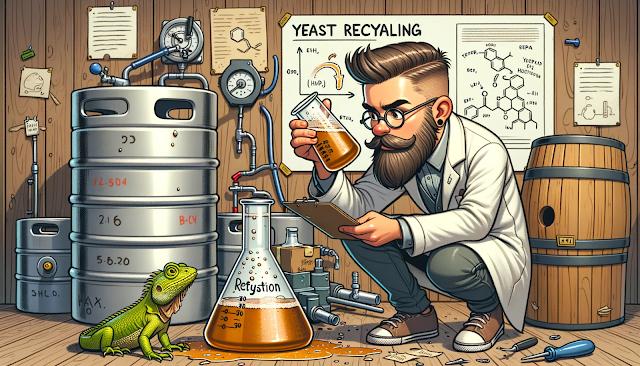Why Cold Crashing Matters
Cold crashing is more than just a way to make your beer look better—it’s about improving flavor and mouthfeel. By dropping the temperature of your beer post-fermentation, you encourage unwanted yeast, hop particles, and other suspended matter to drop out of suspension and settle at the bottom of the fermenter.As any seasoned brewer will tell you, it’s not just about aesthetics; it's about making sure your beer has the cleanest taste possible. Cold crashing also helps in the conditioning process, allowing your beer to mature without interference from lingering fermentation byproducts.
What You Need for Cold Crashing
To cold crash your beer properly, you’ll need to set up your space and equipment with precision. Here’s a quick rundown of what you’ll need:Fermentation Vessel with an Airlock: This is your primary containment, and it needs to be sealed tight to keep contaminants out. An airlock allows gases to escape but prevents air from entering as the beer cools and contracts.
Temperature-Controlled Refrigerator: Cold crashing requires consistency. You don’t need a specialized brewing fridge, but a modified household fridge or chest freezer with a temperature controller will work. The goal is to maintain a stable, cold temperature without freezing your beer.
Thermometer: A digital thermometer or temperature strip on your fermenter will give you precise readings. Accuracy here is crucial—if your beer warms up too much, it might lose some of the benefits of cold crashing.
Sanitization Tools: As with any step in the brewing process, cleanliness is essential. Sanitize all equipment that will come into contact with your beer to prevent any chance of contamination, especially when handling beer at lower temperatures.
The Cold Crashing Process: Step-by-Step
Now that you’ve got your gear ready, it’s time to dive into the process:Ensure Fermentation Is Complete: Cold crashing is only effective once fermentation is finished. Use a hydrometer to check the specific gravity. If the reading has been stable for at least two days, fermentation is complete. You’ll also know it’s ready if the beer tastes dry with no residual sweetness.
Set the Temperature: Aim for a temperature range between 32-40°F (0-4°C). Lagers typically benefit from the colder end of that spectrum, while ales can handle slightly warmer temperatures. Be mindful not to go too cold—freezing temperatures can cause unwanted issues like beer expansion or ice formation in your vessel.
Duration: Most beers will need 24-48 hours to cold crash properly. For beers with a higher sediment load (think stouts or heavily dry-hopped IPAs), you may need to extend this to 72 hours. The more sediment, the longer it will take to fully settle.
Monitor the Process: Keep a log of your cold crash temperatures and durations. This can help refine your approach and allow you to repeat successful outcomes with each batch. Small fluctuations in temperature are normal, but consistency is key.
Troubleshooting Common Cold Crashing Issues
Even experienced brewers encounter a few hiccups along the way. Here’s how to handle the most common problems:- Sediment Won’t Drop: If you’re not seeing the clarity you expect after the cold crash, it’s time to reach for fining agents like gelatin. These agents bind to the particles in the beer and help them settle faster. Adding them during the cold crash will make a big difference.
- Over-Carbonation: If you notice excessive fizz in your bottles, this could be due to residual sugars fermenting after bottling. To avoid this, adjust your priming sugar calculations, or use a priming sugar calculator to ensure accuracy.
- Flavor Changes: The flavor can sometimes shift during the cold crash due to factors like yeast strain or improper seal causing oxygen exposure. Make sure your fermenter is properly sealed, and always purge any vessels that come in contact with air to minimize oxidation risks.

Post Cold Crashing Steps
Tips and Best Practices for Cold Crashing
If you’re aiming for the ultimate clarity in your beer, using fining agents can be a game-changer. Fining agents like gelatin or Biofine Clear work by binding to suspended particles in your beer, such as yeast, proteins, and hop matter, helping them settle out more effectively during the cold crash. Gelatin is a popular choice for homebrewers due to its ease of use, typically added during the cold crash, and its ability to clear beer quickly.
Keep in mind that while fining agents can help achieve crystal-clear beer, they can also strip out some of the beer’s body or mouthfeel, so use them with caution depending on the beer style.
Lastly, remember that not all beers benefit from the same cold crashing treatment. For example, a hazy IPA or a New England-style IPA may not need as extended a cold crash as a pilsner or lager, where clarity is a key factor.
Hazy IPAs are known for their cloudy, juicy appearance, and this haze comes from factors like protein and hop particles that contribute to the flavor and mouthfeel. Over-cold crashing these beers can strip away some of that haze and potentially affect the flavor profile.
On the other hand, lagers and pilsners, where clarity is more important, benefit from a longer and colder cold crash to help clear out yeast and sediment.
Cold Crashing vs. Other Clarification Methods
Cold crashing is a great tool, but it’s not your only option. Here’s a quick look at how it compares to other methods:Filtration: While effective, filtration can be cumbersome for homebrewers. It also risks stripping the beer of essential flavors and aromas.
Extended Fermentation: Letting beer ferment longer can naturally clarify it, but this could also affect the flavor profile, depending on the yeast used and the beer style.
Clarifying Agents: These can range from boil additives like Irish Moss to post-fermentation agents like Isinglass or Chitosan, which aid in clearing without the need for a cold crash.





